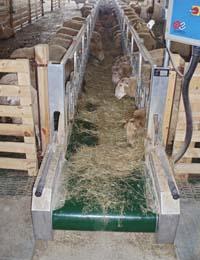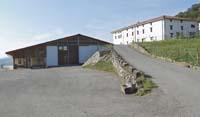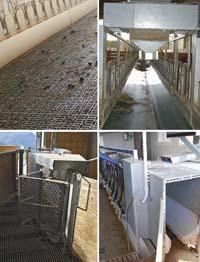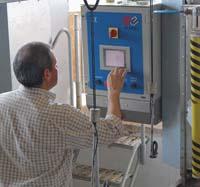Grazing in the current style

The technological innovations introduced have facilitated the daily work of shepherds in sheep management. This is how Batis Otaegi, director of Artzain Eskola told us: "For example, in primitive grazing we used straws and the like to make animal basses." This required the pastor a daily work of one hour or two hours; first the lower parts had to be put on the sheep and then the stained parts were collected and cleaned again.
"In the system we've put now, the shepherds don't have to take work for it," Otaegi told us; "the stable has a plastic grill on the ground, the sheep are in that plastic structure, and from the holes of the grill the sheep manure falls to a pit below." Shepherds should do nothing but collect the accumulated manure in this lower pit.
On the other hand, to feed the sheep they no longer have to go among animals. Otaegi described the discomfort of eating the first animals: "We had to go among the animals; if the sheep were wet, we were wet and did not allow us to eat properly." In addition to avoiding it, they now do it much faster: they distribute the food through conveyor belts. In this way, this tape takes food to the rolled sheep and the shepherd just has to be in a corner of the stable. There is the tool that starts the tape.
In addition, it allows the shepherd to determine the amount of food he will give to each sheep. "Considering that eighty percent of the total money spent by pastoralists is spent on buying food for sheep, this is a way to optimize the largest monetary investment," Otaegi said.
The shepherds have the possibility to divide the sheep into groups (for example when the flock comes from the mountain), to distribute the sheep that have to milk and those that do not have to milk, or to differentiate them according to the amount of milk they produce, etc. To do this they place a microchip in the ventral zone to the sheep that, to introduce them in the stable, make them pass one by one reader.

The reader identifies each sheep and, according to the criterion established by the shepherd, makes it pass to either side of the stable. This work is done by a special door, located behind the reader, which allows each sheep to pass only to one side (closing the access to the other side).
Facilities for milking
Otaegi told us that the time needed to milk the sheep has been reduced to less than half: "The first two people had to spend an hour and a half or almost two hours to milk 220 sheep. Now, one person milks 250 sheep in an hour and a quarter." The shepherds have to choperas the sheep in the udders; from there, the machines do them automatically. The shepherds have two options: milking until everything the sheep give comes out, or defining a milking time so that no more comes out.
The choice of one or the other option is only interrupted after milking: in the first case, when the machine takes ten seconds without pumping and in the second, after the specified time has elapsed. "In this way, they prevent more than enough milking and problems of this kind," Otaegi said.
In addition, thanks to the microchip mentioned above, the shepherd can know how much milk each sheep produces. Another reader has been installed in the milking room, so that "the computer knows where each sheep has been placed and automatically measures the amount of milk taken by the milking machine," explained Otaegi.

Farewell to traditional grazing?
Can traditional grazing be used with the help of technology? That is, would it cease to be traditional grazing if we started using these innovations? Batis Otaegi told us that many believe so. However, at the School of Shepherds Itsasmendikoi do not believe it. They believe that technological advances facilitate the work of pastoralists, but that the sense of traditional pastoralism remains unchanged.
As Otaegi told us, "it would cease to be traditional grazing if we brought sheep from other races, from which they produce more and did not care more in the stables." That is not their goal: "Our goal is to work with native breeds, manage mountain areas and farms, manage the land, keep the prairies clean and ultimately retain a high quality product such as high-end Idiazabal cheese."
In addition, in their opinion, pastors have always used the most advanced technology at their disposal, they have never given up on progress: "In the past, wooden containers and tools were used, as wood was the best material available. But about 30 years ago, stainless steel tools were removed that began to be used. These devices are much easier to clean and are easier to reach hygienic-sanitary conditions." Now Otaegi believes they are facing a similar situation.
Three pillars project

Today Itsasmendikoi Artzain Eskola is the result of the launch by the Franciscan friars of Arantzazu to manage a flock of 300 heads about thirty years ago.
Otaegi told us how the idea of school came about: "The Franciscan Nicolas Segurola and the pastor were one of the ones who most encouraged the creation of the school. It has always been very innovative and I saw that the shepherds could not continue working as before. I saw it necessary to make known to pastors or those who intended to be pastors the innovations that were made in the sector."
Therefore, he began to work on the implementation of the school, reaching an agreement between the Franciscans, the Provincial Council of Gipuzkoa and Itsasmendikoi, the center for training, promotion and integral development of rural areas of the Autonomous Community of the Basque Country. The first placed a flock of sheep, land and hamlet, so that the herd that was launched thirty years ago, took up the work of renovation of the facilities, with the aim of showing the importance of addressing the innovations, and finally Itsasmendikoi adapted the training facilities of shepherds so that anyone who is interested can demonstrate in the most practical and educational way possible the current grazing.
Buletina
Bidali zure helbide elektronikoa eta jaso asteroko buletina zure sarrera-ontzian











